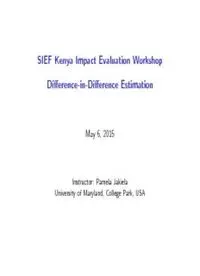
Generating counterfactuals: Differences-in-differences PDF
Preview Generating counterfactuals: Differences-in-differences
SIEF Kenya Impact Evaluation Workshop Difference-in-Difference Estimation May 6, 2015 Instructor: Pamela Jakiela University of Maryland, College Park, USA Overview • Review: false counterfactuals • Difference-in-differences: the intuition • Difference-in-differences: the Stata code • Checking the common trends assumption • A practical example SIEF IE Workshop: Difference-in-Difference Estimation Slide 2 Motivation: False Counterfactuals What Is an Impact Evaluation? “An impact evaluation assesses changes in the well-being of individuals, households, communities or firms that can be attributed to a particular project, program or policy. The central impact evaluation question is what would have happened to those receiving the intervention if they had not in fact received the program. Since we cannot observe this group both with and without the intervention, the key challenge is to develop a counterfactual — that is, a group which is as similar as possible (in observable and unobservable dimensions) to those receiving the intervention. This comparison allows for the establishment of definitive causality — attributing observed changes in welfare to the program, while removing confounding factors.” SIEF IE Workshop: Difference-in-Difference Estimation Slide 4 • A is a policy or intervention • B is an outcome of interest (what we hope to impact) • Examples: ◮ We gave out insecticide-treated bednets, and fewer children under the age of 5 got sick with or died from malaria as a result ◮ We distributed free lunches in elementary schools, and school attendance and/or academic performance went up as a result What Is an Impact Evaluation? Goal: measure causal impacts of policy on participants • We did A; as a result, B happened SIEF IE Workshop: Difference-in-Difference Estimation Slide 5 • Examples: ◮ We gave out insecticide-treated bednets, and fewer children under the age of 5 got sick with or died from malaria as a result ◮ We distributed free lunches in elementary schools, and school attendance and/or academic performance went up as a result What Is an Impact Evaluation? Goal: measure causal impacts of policy on participants • We did A; as a result, B happened • A is a policy or intervention • B is an outcome of interest (what we hope to impact) SIEF IE Workshop: Difference-in-Difference Estimation Slide 5 What Is an Impact Evaluation? Goal: measure causal impacts of policy on participants • We did A; as a result, B happened • A is a policy or intervention • B is an outcome of interest (what we hope to impact) • Examples: ◮ We gave out insecticide-treated bednets, and fewer children under the age of 5 got sick with or died from malaria as a result ◮ We distributed free lunches in elementary schools, and school attendance and/or academic performance went up as a result SIEF IE Workshop: Difference-in-Difference Estimation Slide 5 In an ideal world (research-wise), we could clone each program participant and observe the impacts of our program on their lives vs. Establishing Causality Goal: measure causal impacts of policy on participants • We want to be able to say B happened because of A ◮ We need to rule out other possible causes of B • If we can say this, then we can also say: if we did A again (in another place), we think that B would happen there as well SIEF IE Workshop: Difference-in-Difference Estimation Slide 6 Establishing Causality Goal: measure causal impacts of policy on participants • We want to be able to say B happened because of A ◮ We need to rule out other possible causes of B • If we can say this, then we can also say: if we did A again (in another place), we think that B would happen there as well In an ideal world (research-wise), we could clone each program participant and observe the impacts of our program on their lives vs. SIEF IE Workshop: Difference-in-Difference Estimation Slide 6 In the real world, we either observe Lisa with a book or without • We never observe the counterfactual Establishing Causality In an ideal world (research-wise), we could clone each program participant and observe the impacts of our program on their lives vs. What is the impact of giving Lisa a book on her test score? • Impact = Lisa’s score with a book - Lisa’s score without a book SIEF IE Workshop: Difference-in-Difference Estimation Slide 7
